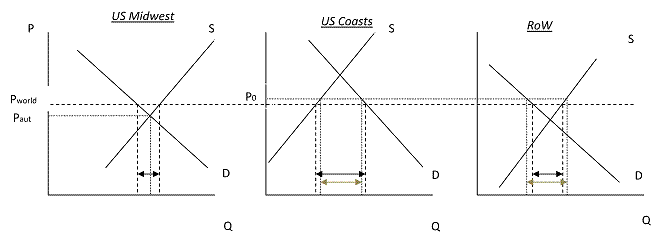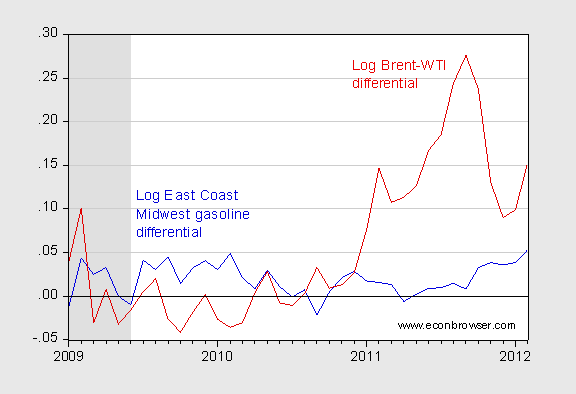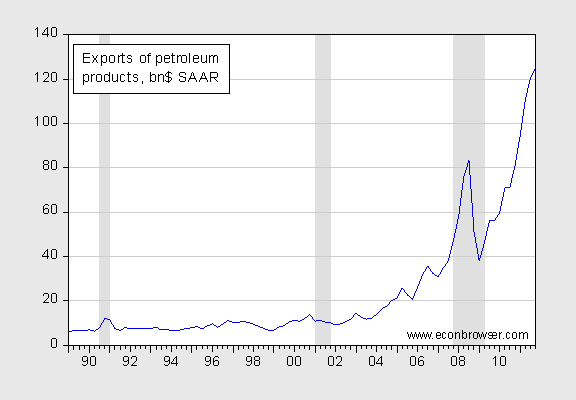Don’t expect a big impact on gasoline prices from opening up an oil pipeline to the coast.
I am a little late to this debate [0] [1] [2], but I wanted to highlight something that is clear from basic international trade theory. Opening up to international trade changes relative prices, and in fact raises some prices. If a pipeline were to be built which could transport oil currently produced in the Midwestern US to the Gulf Coast, then to the extent that oil in the Midwest is lower priced than on the coasts, then average US oil prices may actually rise with completion of the pipeline.
The difference in oil prices in the interior US (West Texas Intermediate) and on the coasts (Brent) is shown in Figure 1.

Figure 1: Price per barrel ($/bbl) of West Texas Intermediate (blue), and Brent (red). NBER defined recession dates shaded gray. Source: St. Louis Fed FRED and NBER.
The analytics of the current situation is shown in Figure 2, which shows the Midwest US market, the US coasts, and the Rest-of-World. The world price (Brent) is at P0, and is above the autarky price for the Midwest at PAut. I’m assuming that in this case, oil cannot be shipped out to the US coasts and to the rest-of-world until the requisite pipelines are in place. (See this NYT article for discussion.)

Figure 2: World oil markets, for US Midwest/interior, US Coasts, and Rest-of-World. Dotted lines denote pre-pipeline prices, quantities. Dashed lines denote post-pipeline prices, quantities.
Once oil can be transported from the interior of the US to the US coasts, then by arbitrage, the US Midwest/interior price (WTI) should rise to world levels, denoted as Pworld. Notice that average US oil prices might very well rise, depending on interior oil production, and the gap between the autarky price and the new world price. (Pre-pipeline imports and exports given by gray arrows, where the US Midwest is in initial balance; post-pipeline trade balances given by black arrows.)
What would happen to gasoline prices? This is hard to say, but to the extent that gasoline is relatively easy to transport (compared to oil), then if average US oil prices rise, US gasoline prices may very well rise. Of course, depending on the parameters, it might fall. The point that gasoline is fairly easy to transport, so law of one price applies with greater force (after accounting for quality differences and restrictions on formulations [3]) is shown by inspecting the oil price differentials and the gasoline price differentials, in Figure 3.

Figure 3: Log East Coast-Midwest price differential for all formulations of gasoline (blue), and log Brent-West Texas Intermediate (WTI) price differential (red). NBER defined recession dates shaded gray. Source: St. Louis Fed FRED, NBER, and author’s calculations.
Notice that despite the widening of the Brent-WTI differential, the East Coast/Midwest gasoline price differential has barely budged.
In fact, the transportability of gasoline and other petroleum products relative to oil explains why the US is now a net exporter of petroleum products. Figure 4 shows petroleum product exports.

Figure 4: Exports of petroleum products, Census basis, bn$ SAAR. NBER defined recession dates shaded gray. Source: BEA, NBER, and author’s calculations.
This analysis suggests that as the price for WTI rises, that for Brent declines (probably slightly, considering relative production levels). Given relative tradability of gasoline, then the crack margins for Midwest refiners should decline, and margins for East coast refiners should increase. That might mitigate the profitability problems of those firms .
The bottom line: One should not expect that increasing the ability to ship oil from the Midwest to the coasts to noticeably decrease oil prices in the US. On the other hand, it is true that welfare (measured as the sum of consumer and producer surplus) should increase, assuming away externalities associated with oil production and transportation.
In any case, the main effects would likely be distributional (between refiners and oil producers, in particular; between refiners in the Midwest and coasts; between consumers and producers; the US and the rest-of-the-world). Gasoline prices will be much more determined by shifts in the Rest-of-world supply and demand curves, as Jim has explained. [4] [5] [6]
Don’t forget that we have enormous over-capacity in crude oil super tankers (Very Large Crude Carriers). Close to 600 globally at last count each capable of carrying 2 million barrels of crude. If tanker rates stay low over the next two or three years then expansion of US pipelines or new pipeline capacity anywhere will have very little effect on the price of oil.
Menzie,
Surprisingly good analysis. Thanks!! Keep up the good work.
Currently WTI is selling at a discount because of transportation bottlenecks. But if you remove the bottlenecks what happens. The surplus oil in the middle of the country will be exported and the discount will disappear. So building the pipeline should lead to higher average prices.
The entire argument over the pipeline from Canada is exactly the same. Without the pipeline Canada will exports its oil through its ports. With the pipeline Canada will ship its oil to refiners on the Gulf Coast who will in turn reexport much of the Canadian crude in the form of refined product. So how much of a difference with the pipeline actually make?
Is it really as simple as that, a pipeline? I think price action often has little to do with supply and demand, or I should say, that’s my suspicion. As I recall, this began as a financial crisis, not an economic crisis…
Anyway, the UN has released an interesting White Paper concerning the commodities market:
http://mpra.ub.uni-muenchen.de/37486/
That is all well and good, but you should consider that the Gulf Coast refineries are generally built to process heavy, sour crude, of which the Canadian Tar Sands can be considered the heaviest and the sourest.
The midwest refineries are generally built to process light, sweet crude.
So the current infrastructure is actually set up backwards.
To some extent the midwest refiners are addressing that. BP is spending $10 billion on their Whiting refinery to refine the tar sands. They already have upgraded their Toledo refinery, and Conoco has a plant near St. Louis that has already been upgraded.
But in general, that XL pipeline would be taking the tar sands to the place that could most use it. I don’t think that it would result in higher midwest prices necessarily, although it certainly could.
Finally, keep in mind that even after XL, there are more tar sands than can be transported by XL. There is still plenty for BP and Conoco in their midwest refineries, and in fact more pipelines need to be built.
Nice analysis and ensuing discussion.
I’m not as well versed with the mid-stream and downstream sectors as some posters appear to be but I have to reckon that the USA clearly enjoys some kind of competitive advantage in the field of oil refining and producing petroleum products. There is much pre-existing capacity that can be quickly retrofitted compared to other rich western countries where existing refining capacity is insufficient and local interests effectively block greenfield refiners.
On a personal note, my wife and I flew over the northern Gulf of Mexico coast on our way back from 10 days of backpacking in the Golden Trout Wilderness area of the SE Sierra Nevada mountains in California. The knee deep petrochemical industry that straddled much of the Texas Gulf coast and places further east shocked me. It was indeed an epiphany but not in typical uplifting way.
In subsequent years, I have learned that for a juxtaposition of strange reasons, refineries are more often than not ‘capital sinks’.
Why some Canadians clamour for more oil refineries in Canada puzzles me. They are like wealth-destroying vanity assets but with emissions and some trying aesthetics. Perhaps most don’t fully understand their full ghastliness. I say let American and Asian buyers have all the unrefined dilbit they want. Pipelines have such a tiny footprint by comparison.
Buzzcut: I would like to remind you that this is an academic forum. To be technically correct, you should say bitumen not tarsands. -hehe- Actually the industry would prefer you to say oilsands. Of course, you could always play it safe and simply Canadian heavy oil. I trust everybody understands that these terms, what they imply and the emotional reaction they solicit have billion dollar consequences.
I have a question for Menzie and fellow forum participants: this blog site and virtually all discussion sites where energy policy gets discussed focus almost solely on supply-side issues. There is little or no discussion of demand issues such as regulations versus more price mechanisms such as consumption taxes. Everybody from all political perspectives seem to support the agenda of cheap, inexpensive energy.
westslope: See my post, Tackling “Oil Addiction” from February 2006. I personally think a policy of “Drill, baby, drill” is fated to come to grief.
Thanks Menzie.
This business about substituting for foreign oil or the “oil of our enemies” is also rather curious. Oil is a non-renewable resource so why should one be concerned about using up the enemies’ oil supply? Wouldn’t a rational policy maker encourage buying oil–a non-renewable resource–from the ‘enemy’?
westslope: Largely agree; Jeff Frankel has called oil production subsidies and other incentives to drill in the US the “drain America first” policy.
In my view, we should be aiming to raise taxes on gasoline over time, as I laid out in my 2005 Council on Foreign Relations Special Report.
I found a NYT editorial first published in 2006: Drain America First
Jeff Frankel blogs here: Offshoring is a Dubious Policy, When the Question is Oil Drilling
The way I see it, there is little or no difference between Democrat and Republican policy with regards to “draining America first”. And from here I can’t tell which party is more xenophobic or inclined to kill and take.